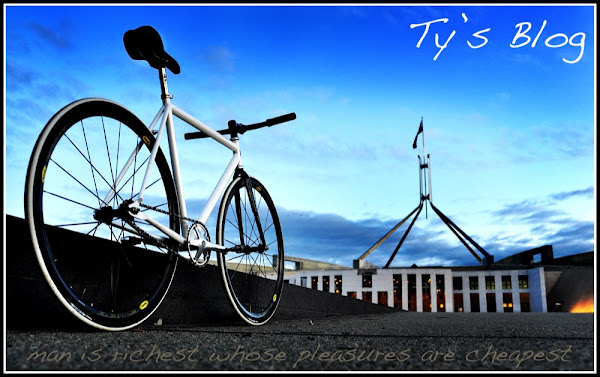
The frame is a Ventana El Commandante. A 29er hard-tail singlespeed specific frame hand made in the United States. I chose this bike for it's reputation as being very strong and light, making it a good all-round reliable frame to base an endurance racing bike on. It's geometry isn't too racy, which means I can set it up for all day riding and maintain comfort for hours in the saddle.

I choose to race single speed ultimately because I like the simplicity of a single speed bike; however, in a race situation it's a mixed bag with respect to pros and cons. Yes, of course it's lighter and more reliable but it also takes a bit more effort to roll over a course for an extended period of time as you need to spend a lot of time standing and grinding up hills, this in turn makes you fatigue earlier than a geared counterpart. This would seem like a disadvantage, but the fact that you are forced to grind up the hills hold it's own benefits. We all know the slower you pedal, the harder a hill climb gets, so when I hit a hill on the SS I know that I need to maintain a high a cadence as possible and push myself to the top of the hill faster than most of the geared soloists. I seem to be overtaking all of the time and hear remarks like "freak" or "what the...", if only they knew I had no choice but to push up the hills!!

I run a 32:21 gearing, which seems a bit slow, but helps maintain my legs on the climbs and is enough to give me a kick start on the downhills. The only place I suffer is the flat fire trails, where top speed is around 30km/h, but I like to use the flats as an enforced rest area instead of wasting energy on wind resistance.
I use wax lube. It's messy, but no matter what the terrain it sticks for at least a couple of laps. Most 24hr race courses get very dusty due to the traffic and I find that conventional lubes dry up as a result.

I choose to use a 100mm travel fork with lock-out. There is no way I would ever install a fork without lock-out on my single speed, mainly due to the out of the saddle climbing that I do. It's almost impossible to be efficient out of the saddle and the remote lock-out soon becomes second nature, although I have been known to leave it on for long periods of time without realising.

Bar ends are another must have for climbing, and they double as lever protection. The number of times these things have taken an impact instead of my hands or brake levers is unbelievable. You will also notice that the brake levers are inboard considerably, this is so that I can maintain as much leverage as possible with the use of a single finger. Luckily, the Avid BB7s are good enough that they only need one finger. I trust these brakes more than I trust any other brake, and they are cable actuated!!! The best brakes in the world in my opinion, and they have proved themselves tuffer than hydros time and time again.

Tyres are a hard thing to choose considering some races are held in areas I have never ridden and weather is always unpredictable. That's why I run Maxxis Crossmark. These tyres have never let me down and perform flawlessly in all terrain, wet or dry. I run them tubed (with Stan's inside the tubes) as I don't need to worry about pinch flats with the 29ers and it makes changing a tube on the trail 20 times easier and less messy.


Pedals are a no brainer. I own six sets of Crank Brothers pedals, they are fitted to all of my bikes (road, mtb, track, commuter and cruiser). They shed mud and dirt, give me enough rotation and.....well, just work. I had a seven year old pedal fail at the Scott 24 hour and exchanged it between laps. Once I got home I fitted a rebuild kit ($US15) and the pedal is as good as brand new.

Spares are very important as once you have left transition, you are on your own and you can't rely on passers by to have what you need, nor should you expect to (although this seems to be the norm for some people). I have a spare tube fitted to my saddle, just to free up space in my pockets, and I carry a kit.

The kit contains a CO2 pump for quick tyre inflation. It double as a pump in case the CO2 fails or I have another puncture during the lap. I also carry a multi tool with chain breaker, emergency patches, some chain links and a segment of chain in case the chain is quite damaged.

These tools will get me through most of what the race can throw at me, and if not, hopefully I still have my legs.
